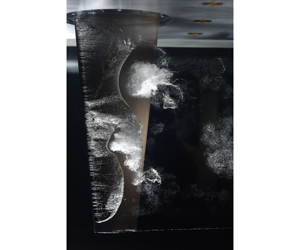Published online by Cambridge University Press: 26 May 2020

The physics associated with various cavitation regimes about a hydrofoil is investigated in a variable-pressure water tunnel using high-speed photography and synchronised force measurements. Experiments were conducted on a relatively stiff stainless steel hydrofoil at a chord-based Reynolds number,  $Re=0.8\times 10^{6}$ for cavitation numbers,
$Re=0.8\times 10^{6}$ for cavitation numbers,  $\unicode[STIX]{x1D70E}$, ranging from 0.2 to 1.2, with the hydrofoil experiencing sheet, cloud and supercavitation regimes. The NACA0009 model of tapered planform was vertically mounted in a cantilevered configuration to a six-component force balance at an incidence,
$\unicode[STIX]{x1D70E}$, ranging from 0.2 to 1.2, with the hydrofoil experiencing sheet, cloud and supercavitation regimes. The NACA0009 model of tapered planform was vertically mounted in a cantilevered configuration to a six-component force balance at an incidence,  $\unicode[STIX]{x1D6FC}$, of
$\unicode[STIX]{x1D6FC}$, of  $6^{\circ }$ to the oncoming flow. Tip deformations and cavitation behaviour were recorded with synchronised force measurements utilising two high-speed cameras mounted underneath and to the side of the test section. Break-up and shedding of an attached cavity was found to be due to either interfacial instabilities, re-entrant jet formation, shockwave propagation or a complex coupled mechanism, depending on
$6^{\circ }$ to the oncoming flow. Tip deformations and cavitation behaviour were recorded with synchronised force measurements utilising two high-speed cameras mounted underneath and to the side of the test section. Break-up and shedding of an attached cavity was found to be due to either interfacial instabilities, re-entrant jet formation, shockwave propagation or a complex coupled mechanism, depending on  $\unicode[STIX]{x1D70E}$. Three primary shedding modes are identified. The Type IIa and IIb re-entrant jet-driven oscillations exhibit a non-linear dependence on
$\unicode[STIX]{x1D70E}$. Three primary shedding modes are identified. The Type IIa and IIb re-entrant jet-driven oscillations exhibit a non-linear dependence on  $\unicode[STIX]{x1D70E}$, decreasing in frequency with decreasing
$\unicode[STIX]{x1D70E}$, decreasing in frequency with decreasing  $\unicode[STIX]{x1D70E}$ due to growth in the cavity length, and occur at higher
$\unicode[STIX]{x1D70E}$ due to growth in the cavity length, and occur at higher  $\unicode[STIX]{x1D70E}$ values (Type IIa: 0.4–1.0; Type IIb: 0.7–0.9). Shockwave-driven Type I shedding occurs for lower
$\unicode[STIX]{x1D70E}$ values (Type IIa: 0.4–1.0; Type IIb: 0.7–0.9). Shockwave-driven Type I shedding occurs for lower  $\unicode[STIX]{x1D70E}$ values (0.3–0.6) with the oscillation frequency being practically independent of
$\unicode[STIX]{x1D70E}$ values (0.3–0.6) with the oscillation frequency being practically independent of  $\unicode[STIX]{x1D70E}$. The Type IIa oscillations locked in to the first sub-harmonic of the hydrofoil’s first bending mode in water which has been modulated due to the reduced added mass of the vapour cavity. Supplementary movies are available with the online version of the paper.
$\unicode[STIX]{x1D70E}$. The Type IIa oscillations locked in to the first sub-harmonic of the hydrofoil’s first bending mode in water which has been modulated due to the reduced added mass of the vapour cavity. Supplementary movies are available with the online version of the paper.
At σ = 1.2, the hydrofoil is seen to experience sheet cavitation where the attached cavity is confined to a small portion of the chord towards the leading edge with length of Lc/c ~ 0.2. The cavity is broken-up into small scale structures driven primarily by inter-facial instabilities such as Kelvin-Helmholtz driven spanwise vorticity lines and turbulent transition.
As σ is reduced to 1.0, cloud cavitation is seen to occur with the conditions allowing a re-entrant jet to form and reach the upstream extent of the cavity, causing periodic detachment and the formation of a cavitation cloud. This is seen to be confined to around the mid-span with only the detachment of small bubbly vortices occurring towards the spanwise extents.
Multiple stable shedding modes form along the span of the hydrofoil as σ reaches 0.8 with the Type IIa mode shedding at St = 0.408 in the upper portion of the span (0.0 < y/b < 0.4), while the Type IIb mode sheds at St = 0.500 in the lower portion (0.6 < y/b < 0.8).
Further reduction in σ to 0.7 sees the hydrofoil enter lock-in where the Type IIa shedding frequency matches a sub-harmonic of the hydrofoil leading to amplified structural excitations. The Type IIa shedding is seen to occur across majority of the span with only small broken-up clouds shed towards the tip.
As σ reaches 0.6, the attached cavity now extends to the trailing edge of the hydrofoil with both re-entrant jet and shockwave instabilities present in the flow. The re-entrant jet can be seen slowing down as it approaches the upstream extent of the cavity, stalling before causing detachment. This leads to perturbations to form over the cavity, resulting in small-scale break-up generating a bubbly flow of high void-fraction. This preconditions the flow to allow shockwave propagation that cause the shedding of the cloud cavitation where the re-entrant jet instability drives the frequency that the shedding occurs.
With σ reducing to 0.4, the cavity extends beyond the hydrofoil trailing edge with a re-entrant jet still forming but lacking momentum to reach the upstream extent of the cavity. The shockwave instability is prevalent in this condition which is characterized by alternate shedding from the upper and middle portion of the span with this sequence featuring an irregular shedding event in the lower portion.
At σ = 0.3, the shedding is solely driven by shockwave propagation where a re-entrant jet still forms but lacks sufficient time and momentum to reach the upstream extent of the cavity. This results in the shockwave driving the shedding frequency at a rate of St = 0.091 where a cycle consists of a large-scale cloud is shed from the upper portion of the span, followed by two smaller scale clouds in quick succession.
As σ reaches 0.2, the cavity grows to a length of Lc/c ~ 1.5, thus forming a supercavity. Closing far downstream of the trailing-edge with no strong adverse pressure gradient present, the supercavity becomes more stable than partial cavities as no substantial shedding mechanisms can form.